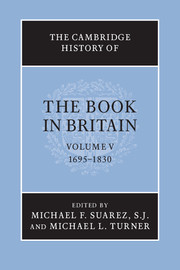Book contents
- Frontmatter
- Introduction
- PART I THE QUANTITY AND NATURE OF PRINTED MATTER
- PART II ECONOMIC, LEGAL AND CULTURAL CONTEXTS
- PART III THE TECHNOLOGIES AND AESTHETICS OF BOOK PRODUCTION
- PART IV THE BOOK TRADE AND ITS MARKETS
- I LONDON AND THE ‘COUNTRY’
- II TWO CASE STUDIES
- III SERIAL PUBLICATION AND THE TRADE
- 20 London newspapers
- 21 Newspapers and the sale of books in the provinces
- 22 British commercial and financial journalism before 1800
- 23 Distribution – the case of William Tayler
- 24 Periodicals and the trade, 1695–1780
- 25 Periodicals and serial publications, 1780–1830
- IV THE INTERNATIONAL MARKET
- V BOOKS AND THEIR READERS
- Abbreviations used in bibliography
- Bibliography
- Index
- Frontispiece
- Plate section
- References
25 - Periodicals and serial publications, 1780–1830
from III - SERIAL PUBLICATION AND THE TRADE
Published online by Cambridge University Press: 28 September 2010
- Frontmatter
- Introduction
- PART I THE QUANTITY AND NATURE OF PRINTED MATTER
- PART II ECONOMIC, LEGAL AND CULTURAL CONTEXTS
- PART III THE TECHNOLOGIES AND AESTHETICS OF BOOK PRODUCTION
- PART IV THE BOOK TRADE AND ITS MARKETS
- I LONDON AND THE ‘COUNTRY’
- II TWO CASE STUDIES
- III SERIAL PUBLICATION AND THE TRADE
- 20 London newspapers
- 21 Newspapers and the sale of books in the provinces
- 22 British commercial and financial journalism before 1800
- 23 Distribution – the case of William Tayler
- 24 Periodicals and the trade, 1695–1780
- 25 Periodicals and serial publications, 1780–1830
- IV THE INTERNATIONAL MARKET
- V BOOKS AND THEIR READERS
- Abbreviations used in bibliography
- Bibliography
- Index
- Frontispiece
- Plate section
- References
Summary
Although the period between 1780 and 1830 provides the moment when the idea of seriality begins to become identifiable (and indeed popular) as a mode of textual production, the borderlines between periodical and book, ‘issue’ and volume, or serial and series remained through these years both blurred and increasingly contested. The whole period might be characterized by an often unselfconscious and unresolved – even haphazard – dialogue between seriality, periodicity and the volume format, a dialogue that can, historically, be given shape through the wider growth and democratization of print culture in the period. Literature directed towards children, for example, shows relatively few titles that can be clearly identified as ‘magazines’, but many projects dependent on seriality or part-issue, such as miscellanies or series. Frequently, part-issues were later turned into volumes, a transition that clearly shows how far periodicity was conceived as an accumulative rather than an occasional form of publication. The Youth’s Monthly Visitor, for instance, published in 1822 and 1823 in serial form, became the Youth’s Miscellany of Knowledge and Entertainment on volume republication. The emergence of something clearly identifiable as a magazine from what John Brewer calls the ‘labyrinth’ of late eighteenth-century publishing forms a recurrent narrative of the period.
- Type
- Chapter
- Information
- The Cambridge History of the Book in Britain , pp. 498 - 512Publisher: Cambridge University PressPrint publication year: 2009
References
- 2
- Cited by

